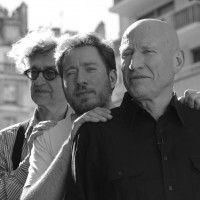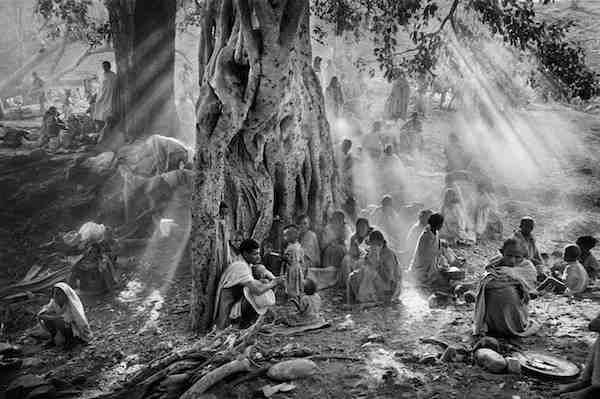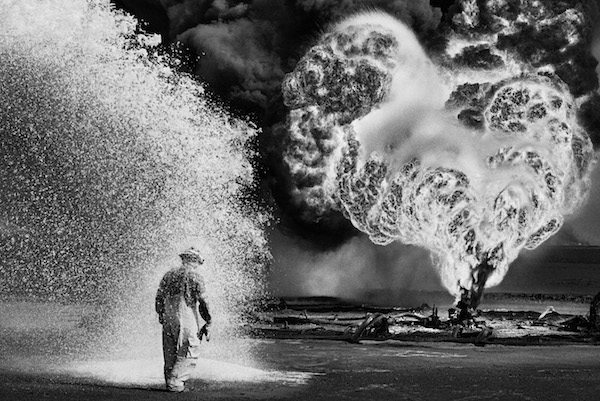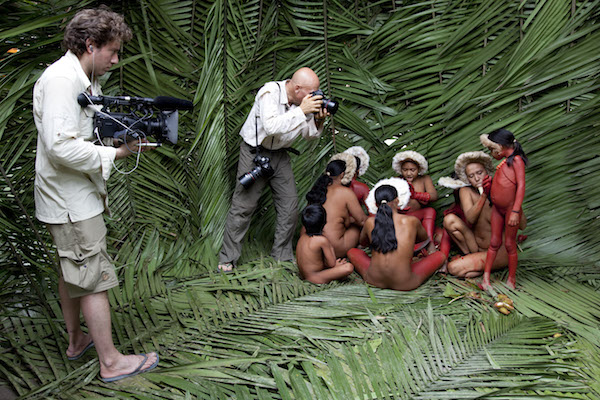An Empathetic Photographer and His Work

Wim Wenders, J. R. Salgado, S. Salgado; courtesy of Sony Pictures Classics
For 40 years, the Brazilian-born photographer Sebastião Salgado has been documenting people and events around the world, driven by curiosity, adventure, and deep empathy for the human condition. Trained as an economist, he left the security of that profession to travel to such farflung places as the Arctic Circle, remote Andes villages, Kuwait, and several African nations, where he lived among locals and immersed himself in the culture. The resulting collections of stunning black and white images include his books Other Americas, Workers, Terra, Exodus and Africa.
At one point, soul-sick from the tragedy he had witnessed in Rwanda, Salgado lost his desire to work, but regained it when he and his wife/work partner Lélia decided to replant the forest around the family ranch. That project ultimately became Instituto Terra, a thriving ecological reserve. Salgado’s current work involves the discovery and documentation of untouched landscapes, a tribute to the beauty of the planet.
When Sebastião’s son Juliano Ribeiro Salgado, a documentary filmmaker, decided to make a movie about his father, he enlisted the help of renowned German auteur Wim Wenders, a friend and admirer. The result of their collaboration, The Salt of the Earth, is a beautiful, profound work about a remarkable artist, his family, and the bonds he forges with his subjects. Following are excerpts from a recent roundtable discussion with Wenders and Juliano Salgado:
Did you think about the differences between documenting via photography versus film when making The Salt of the Earth?
Wim Wenders: I don’t think I would have dared get involved in a film about a photographer if I hadn’t already known that this man – who I had become friends with – was a great story teller. Because photos in a movie need protection; without protection they become a slide show. That’s why I like them as prints or in a book but on the screen I feel they’re sort of standing naked. I only got involved in the adventure with Juliano realizing that Sebastião himself was the answer; the wealth of his story and the political, sociological, psychological knowledge of all the places he went to.
Juliano Salgado: That’s what we shared when we started, the idea we weren’t going to make a film about a photographer, but one of the great witnesses of the last 40 years; someone who had lived so much and had so much to pass on.

Courtesy of Sony Pictures Classics
You would say the story is what is protecting the photography?
W: Yeah, Sebastião has this uncanny ability to become part of the humanity he’s witnessing and I was curious about how this was possible because I saw something in his photographs that I hadn’t seen in any others. I saw an empathy and an immersion and I wanted to understand that. I finally found out that it’s time; this man spends more time with these people and he doesn’t take the next plane out because it’s uncomfortable. He stays and lives with these people; he shares the same food and he comes back, sometimes countless times, because he feels he made friends and he can’t abandon them. I realized I only had a right to make a film about this man if I did the same. That meant I had to spend three and a half years with him and his son.
Wim, you’re photographer as well. What did you learn from watching Sebastião work?
W: I learned one thing more than anything else: he invested time. When he was photographing, he forgot about time and he forgot about his own life and he gave as much time as was necessary for a project and sometimes it took years. There are other things he does very differently from other photographers; it’s the uncanny ability to connect via his photographs.
J: I really think that is Sebastião’s great talent. It’s that he manages to connect with people and intuitively he knows where to put the camera so you feel emotionally the thing that’s happening between him and the person. Even in the landscapes, you feel that. When you see his photos, you don’t really feel distance with people who have such different lives.

Courtesy of Sony Pictures Classics
Juliano, you needed Wim for the film to create some distance from your subject; what did that help you gain?
J: At first I thought I’d never make a film of my father because our relationship was so difficult; then I went with him to Amazonia to visit the Zo’e tribe. When Sebastião was back in Paris to edit the photos, he was very touched by them and we started some kind of healing process of our relationship. It also gave me the certainty that maybe it was the right time to make a film. I realized that the important thing was sharing those stories. Wim had the same intuition, but for me it was completely impossible to do those interviews because of how close my father and I were and because of the complex nature of our relationship. When Wim accepted to be part of this adventure, it was amazing, not only the guarantee that there was someone with an outside perspective who knew about images, but also that there would be so much more to the film.
How much do you think the film represents the man you know as your father?
J: Very close actually. I discovered Sebastião, to be honest. I knew the stories, but when I saw it through Wim’s eyes, I understood so much about Sebastião; it helped to actually complete our healing process.
W: I became the family therapist (laughs).
When you have such strong images, how do you create the narration?
W: We thought as we were editing the film that there was only one voice and that’s Sebastião telling these stories, so the two of us completely refrained from interfering. And it took us the longest time to realize that was the wrong approach; we needed to also appear as narrators. I actually brought this young man in with a dirty trick when I realized the arc of the film wasn’t holding. I had all these family photos that they had gathered and I started putting a couple in, starting with a little picture of a baby boy lying there as a bundle. I cut it in; and the next time you (Juliano) saw the cut, you were in it.
J: And that was awful actually… I was thinking, “I’m going to cut it out, I’m going to cut it out!” But then at end it was so sweet and it belonged to the film.
W: It was a great way to introduce you as a voice. It was a huge learning process for the two of us; how two men can make one film.

Courtesy of Sony Pictures Classics
Tell us about this process.
J: It took us a year before we found how to work together on this film, editing-wise. I would try for two months, Wim would see the results and hate it; then he would take the material, edit for three months, and the result wasn’t that great either. Then we decided we would try to sit together at the editing station.
W: We knew we both had material to make respective films. But deep in our heart, we both knew that the film we could make together would definitely be better than the one each of us could make on our own. Eventually we said, I’m going to cut your stuff and you’re going to cut mine and we’ll see what that looks like; and that was painful and not the solution. The solution was, forget whose is whose; this is not yours and this is not mine. We sit together at editing table and cut together and that took us so long and we fought to the bone. When we finally gave up each and every ego tendency any director can have on this planet, we made it our common film. But boy was it painful, I’m never going to do this again (laughs).
What does Sebastião think of the film?
J: He [and Lélia] saw it for the first time a few months ago. When we were about to finish the film we sent them an edit, a little lo-res file; wanted to make sure there wasn’t anything they couldn’t go with, and there wasn’t. And when they saw it for the first time at the Rio Film Festival, it was so emotional. They were holding it together until the moment when Sebastião’s father starts talking about what he thought Sebastião should have been—a lawyer, an economist—and suddenly he starts to break down crying; Lélia too. It was really beautiful actually; a great moment.
The Salt of the Earth opens this Friday.
—Marina Zogbi

